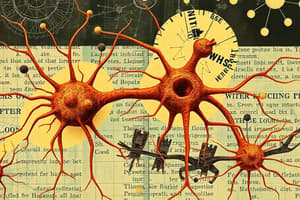Podcast
Questions and Answers
What are the three basic functions of the nervous system?
What are the three basic functions of the nervous system?
- Excitable, Graded, and Action
- Sensory, Integrative, and Motor (correct)
- Neuron, Neuroglia, and Synapse
- Central, Peripheral, and Enteric
What is the difference between gray matter and white matter?
What is the difference between gray matter and white matter?
Gray matter is composed primarily of neuron cell bodies, dendrites, and unmyelinated axons, while white matter is composed primarily of myelinated axons.
Neuroglia are electrically excitable.
Neuroglia are electrically excitable.
False (B)
Which type of neuroglia produces myelin in the CNS?
Which type of neuroglia produces myelin in the CNS?
What type of ion channel is responsible for the rapid depolarization phase of an action potential?
What type of ion channel is responsible for the rapid depolarization phase of an action potential?
Which type of neurotransmitter is involved in the regulation of mood and sleep?
Which type of neurotransmitter is involved in the regulation of mood and sleep?
What is the difference between spatial summation and temporal summation?
What is the difference between spatial summation and temporal summation?
Match the following neurotransmitter to its effect:
Match the following neurotransmitter to its effect:
Flashcards
What is the primary function of the nervous system?
What is the primary function of the nervous system?
The nervous system is responsible for detecting changes in the internal and external environment, processing information, and initiating appropriate responses to maintain homeostasis.
What are the two main divisions of the nervous system?
What are the two main divisions of the nervous system?
The nervous system is made up of the central nervous system (CNS) and the peripheral nervous system (PNS). The CNS includes the brain and spinal cord, while the PNS consists of all the nerves outside the CNS.
What are the three main types of neurons?
What are the three main types of neurons?
Sensory neurons carry information from sensory receptors to the CNS, motor neurons carry commands from the CNS to effectors (muscles, glands), and interneurons process information within the CNS, connecting other neurons.
What are neuroglia, and what is their role in the nervous system?
What are neuroglia, and what is their role in the nervous system?
Signup and view all the flashcards
What is myelin, and what is its function?
What is myelin, and what is its function?
Signup and view all the flashcards
What is the difference between gray matter and white matter?
What is the difference between gray matter and white matter?
Signup and view all the flashcards
What is the resting membrane potential?
What is the resting membrane potential?
Signup and view all the flashcards
What are graded potentials?
What are graded potentials?
Signup and view all the flashcards
What are action potentials?
What are action potentials?
Signup and view all the flashcards
What is the threshold of an action potential?
What is the threshold of an action potential?
Signup and view all the flashcards
What happens during depolarization and repolarization in an action potential?
What happens during depolarization and repolarization in an action potential?
Signup and view all the flashcards
What is the refractory period?
What is the refractory period?
Signup and view all the flashcards
What are continuous conduction and saltatory conduction?
What are continuous conduction and saltatory conduction?
Signup and view all the flashcards
What factors affect the speed of nerve impulse conduction?
What factors affect the speed of nerve impulse conduction?
Signup and view all the flashcards
What is a synapse?
What is a synapse?
Signup and view all the flashcards
What are the two main types of synapses?
What are the two main types of synapses?
Signup and view all the flashcards
Describe the process of signal transmission at a chemical synapse.
Describe the process of signal transmission at a chemical synapse.
Signup and view all the flashcards
What are EPSPs and IPSPs?
What are EPSPs and IPSPs?
Signup and view all the flashcards
What is summation in the context of synaptic transmission?
What is summation in the context of synaptic transmission?
Signup and view all the flashcards
What are neurotransmitters?
What are neurotransmitters?
Signup and view all the flashcards
What are neural circuits?
What are neural circuits?
Signup and view all the flashcards
Describe the regenerative capacity of nervous tissue.
Describe the regenerative capacity of nervous tissue.
Signup and view all the flashcards
What is multiple sclerosis?
What is multiple sclerosis?
Signup and view all the flashcards
What is depression?
What is depression?
Signup and view all the flashcards
What are epilepsy and excitotoxicity?
What are epilepsy and excitotoxicity?
Signup and view all the flashcards
Study Notes
Nervous Tissue Overview
- Nervous tissue is a specialized type of biological tissue that carries information throughout the body.
- Its purpose is to maintain homeostasis by controlling conditions in the body.
Purpose of the Chapter
- Understand how the nervous system maintains stable internal environments for health.
- Learn about the different parts of the nervous system.
- Learn about different types of nerve cells.
Nervous System Overview
- The nervous system has two main divisions; Central Nervous System (CNS) and Peripheral Nervous System (PNS).
- The CNS includes the brain and spinal cord.
- Sensory neurons are specialized cells that respond to stimuli by the body and transmit signals to the CNS.
- Interneurons are located in the brain and spinal cord; process and integrate information gathered by sensory neurons,
- Motor neurons will send signals away from the CNS to muscles to respond to the stimulus.
Nervous System Organization
- The PNS consists of cranial and spinal nerves.
- Autonomic nervous system regulates involuntary actions such as heart rate.
- Somatic nervous system controls voluntary actions such as movement.
- Enteric plexuses in the gut regulate digestive processes.
- Sensory receptors in skin detect external stimuli, such as temperature.
Nervous System Functions
- Sensory: Detecting changes using sensory receptors.
- Integrative: Processing incoming sensory information, analyzing it, storing aspects of it, and making decisions for appropriate behaviors.
- Motor: Responding to stimuli by actions via effectors.
Nervous System Histology
- Neurons are electrically excitable cells that transmit nerve impulses.
- Neuroglia support neurons; maintain the body's chemical environment, multiply, and divide.
Neuron Structure
- Electrically excitable
- Cell body containing nerve impulses
- Dendrites receive signals
- Axon transmits signals
- Action potentials are nerve impulses
Neuron Classification (Structure)
- Multipolar: many processes extending from the cell body
- Bipolar: two processes extending from the cell body
- Pseudounipolar: one process extending from the cell body that divides into two branches
Neuron Classification (Function)
- Sensory (afferent): carry information from sensory receptors to the CNS
- Motor (efferent): carry information from the CNS to effectors (muscles or glands)
- Interneurons: connect neurons within the CNS
Neuroglia (CNS)
- Astrocytes: support neurons, maintain chemical balance
- Oligodendrocytes: produce myelin
- Microglia: phagocytes (immune function)
- Ependymal cells: line cavities, circulate cerebrospinal fluid (CSF)
Neuroglia (PNS)
- Satellite cells: support neurons
- Schwann cells: produce myelin
Myelination of Neurons
- Myelin sheath is a fatty layer produced by Schwann cells in the PNS and oligodendrocytes in the CNS.
- Increases the speed of nerve impulse conduction.
- Nodes of Ranvier are gaps in the myelin sheath where action potentials are generated.
Gray Matter vs White Matter
- Gray matter contains neuron cell bodies and dendrites.
- White matter primarily contains axons and myelin.
Electrical Signals in Neurons
- Communication between neurons occurs using actions potentials and graded potentials.
- Action potentials travel long distances, graded potentials short distances.
- Graded potentials change the membrane potential from the resting potential.
Ion Channels in Neurons
- Leakage channels continuously open and close; maintain the resting membrane potential.
- Ligand-gated channels open in response to neurotransmitters.
- Mechanically gated channels open in response to mechanical stimuli (pressure, vibration)
- Voltage-gated channels open in response to changes in membrane potential.
Resting Membrane Potential
- The membrane of a non-conducting neuron is negatively charged inside and positively charged outside.
- This is established by unequal ion distribution, selective permeability of the membrane to specific ions, and active transport using Na+/K+ pumps.
Graded Potentials
- Small changes in the membrane potential, caused by various stimuli.
- Can be depolarizing (making the inside less negative) or hyperpolarizing (making the inside more negative).
- Do not propagate down the axon as action potentials do.
Summation of Postsynaptic Potentials
- A series of graded potentials add up to determine whether an action potential will be relayed.
- Summation can be spatial or temporal, meaning several inputs together or continuous inputs, respectively.
Action Potentials
- Rapid changes in membrane potential; occur when the graded potentials reach a threshold.
- Two Phases: Depolarization begins as sodium ions enter the axon, repolarization occurs as potassium ions leave the axon.
Propagation of Action Potentials
- Action potentials are propagated along the axon for communication.
- The signal is generated at the axon hillock.
- Continues down the axon because of sodium and potassium channels on the membrane.
Factors Affecting Propagation Speed
- Axon diameter: Larger diameter axons conduct APs faster.
- Myelination: Myelin sheath increases speed.
- Temperature: Higher temperatures speed up APs.
Signal Transmission At Synapses
- Chemical synapses are one-way transfer of information from a presynaptic neuron to a postsynaptic neuron.
- Electrical synapses transmit info bi-directionally via gap junctions.
Postsynaptic Potentials
- Excitatory postsynaptic potentials (EPSPs): depolarizing.
- Inhibitory postsynaptic potentials (IPSPs): hyperpolarizing.
Neurotransmitter Receptors
- Two structures for receptors: Ionotropic and Metabotropic.
- Ionotropic have a binding site and an ion channel, whereas metabotropic have a binding site and a G-protein which controls the opening/closing/activation of separate ion channels.
Removal of Neurotransmitters
- Diffusion: Neurotransmitter diffuses away from the synaptic cleft.
- Degradation: enzymes break down the neurotransmitter.
- Uptake into cells: neurotransmitter is transported back into presynaptic neuron or other cells in the area.
Summation
- Summation can be spatial (Multiple inputs at once) or temporal (Inputs one after another in quick succession).
- The sum of ESPS's and IPSP's will determine if an action potential will be generated.
Action Potentials and Synapses
- Synapses are the junction between neurons.
- Action potentials are propagated.
- Multiple synapses can summate to generate an action potential.
Neuronal Regeneration and Repair
- Neurons have limited ability to regenerate.
- The process is dependent on whether the cell body and nerves around it are intact.
Neurogenesis
- Neurogenesis (CNS regeneration) is limited and there is no ability to replace old neurons as quickly as other cells.
Neuronal Disorders
- Multiple sclerosis is an autoimmune disease that progressively destroys the myelin sheath.
- Depression is several types of disorders where common feelings are lack of interest in activities, sadness, helplessness and possibly suicidal thoughts.
Other Neural Disorders
- Epilepsy is a neurological disorder characterized by seizures.
- Excitotoxicity is a neuronal death caused by overstimulation, usually due to high levels of neurotransmitter in the CNS. Note: Neuroglia play an important role in both excitatory and inhibitory responses and thus this phenomenon.
Studying That Suits You
Use AI to generate personalized quizzes and flashcards to suit your learning preferences.




